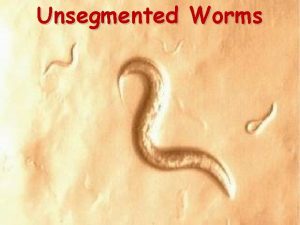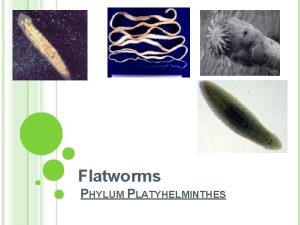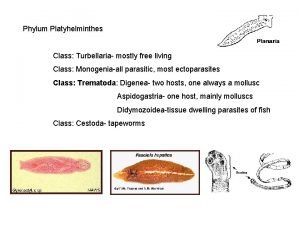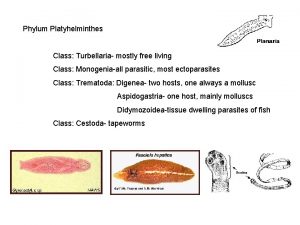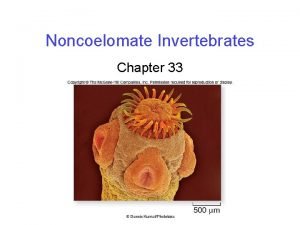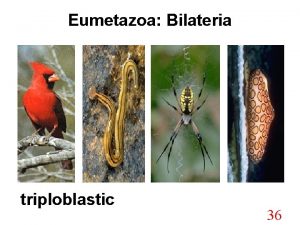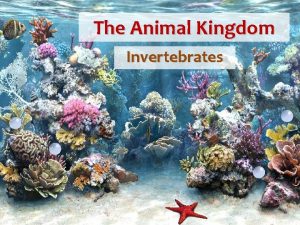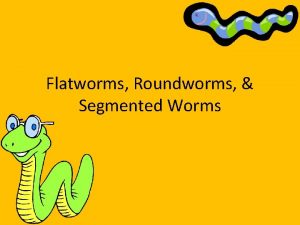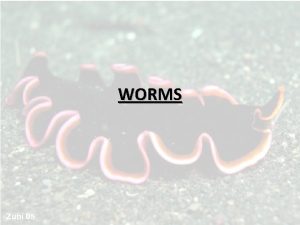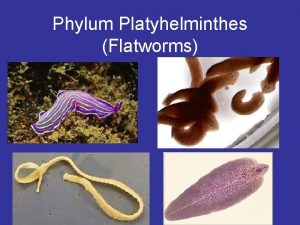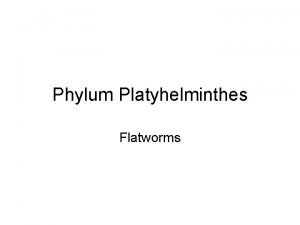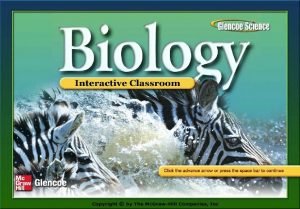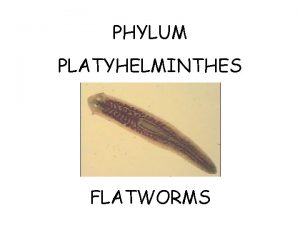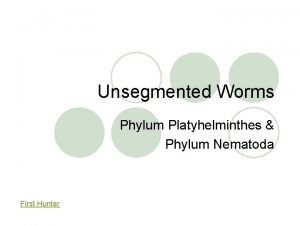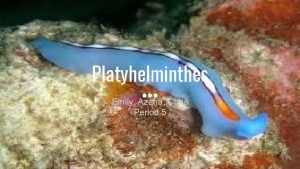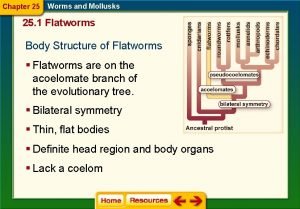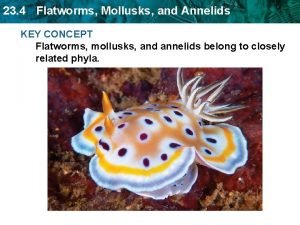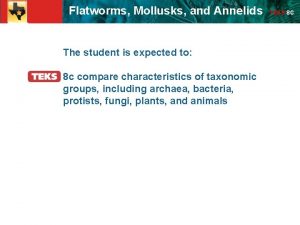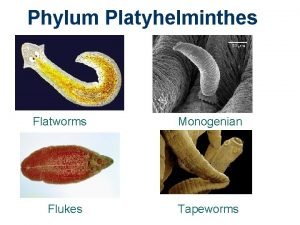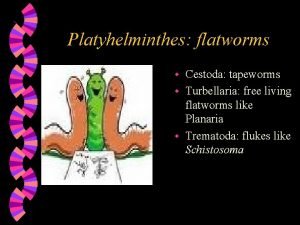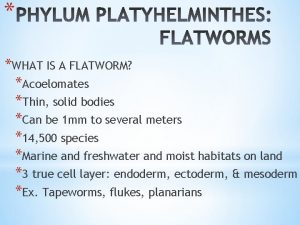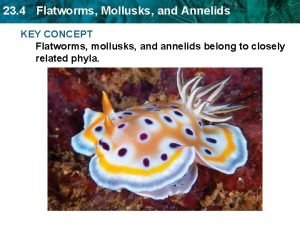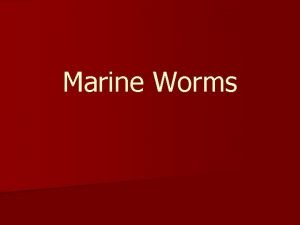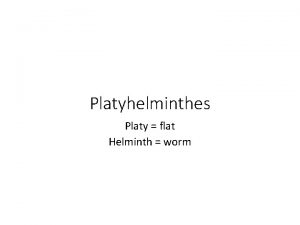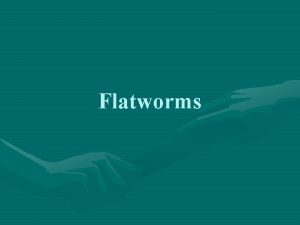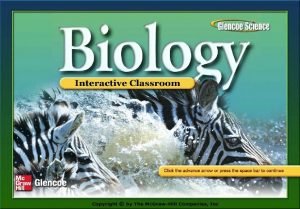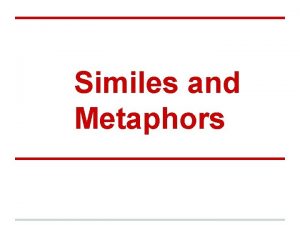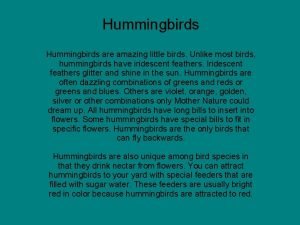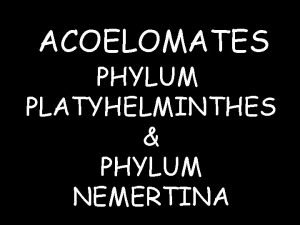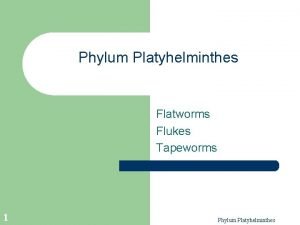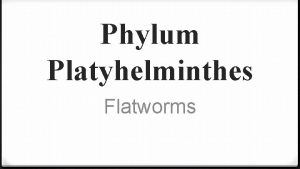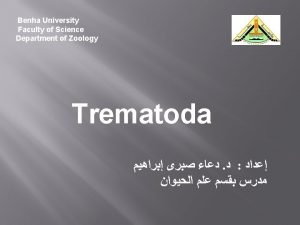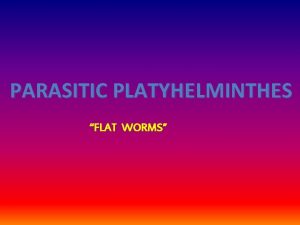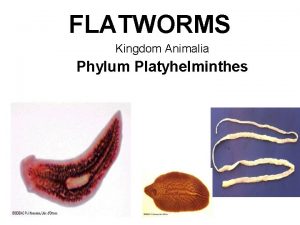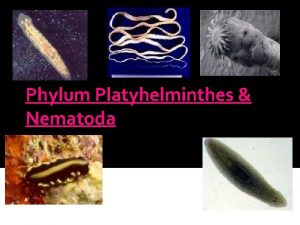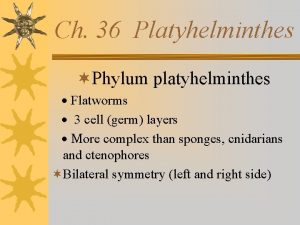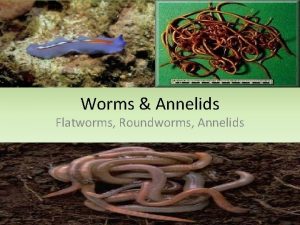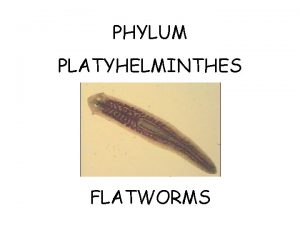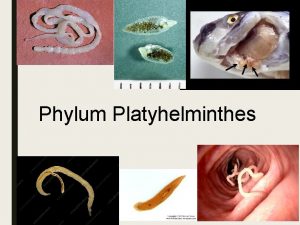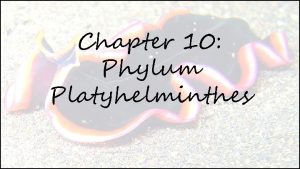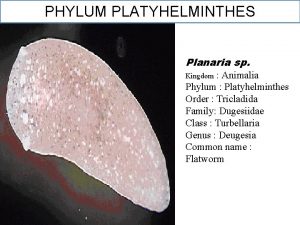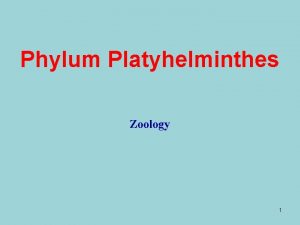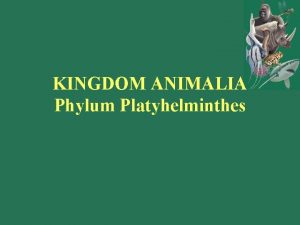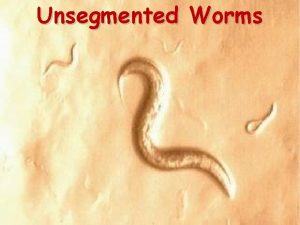Phylum Platyhelminthes Flatworms Phylum Platyhelminthes n Unlike other






































- Slides: 38

Phylum: Platyhelminthes (Flatworms)

Phylum Platyhelminthes n Unlike other animals encountered so far, Platyhelminthes: have evolved cephalization with their sense organs concentrated at the head end. n Have a ladder-type nervous system. n are bilaterally symmetrical. n Are dorsoventrally flattened. n

n In addition they are triploblastic, but lack a coelom. Instead, they have a solid body filled with parenchyma cells. n have evolved organs and in some cases organ systems. n n The first (and simplest) excretory or osmoregulatory systems and circulatory systems are found in members of these groups. Platyhelminthes usually slender and leaflike or ribbonlike. Unsegmented. Have no circulatory or respiratory organs. Flat body increases surface area and allows the animal to exchange gas and lose wastes by diffusion.


Nutrition n n The digestive system includes a mouth, pharynx, and blind intestine (the gut is incomplete). In the free-living Turbellarians the pharynx can be everted from the mouth. Food is sucked into the intestine where a combination of extracellular and intracellular digestion takes place. Undigested food exits via the pharynx. In the Cestoda the digestive tract is absent and all nutrients are absorbed across the tegument (the syncytial membrane/body covering found in all parasitic Platyhelminthes).


Excretion/Osmoregulation n n The osmoregulatory system consists of a series of canals that end in flame cells or protonephridia. This system appears mainly intended to remove excess fluid, but retain essential ions. It is most developed in freshwater Turbellarians, but reduced or absent in marine species, which do not have to remove excess water.

Nervous system and sense organs n Flatworms possess a simple brain and one to five pairs of longitudinal nerve cords that are cross connected to form a ladder-like arrangement.

Reproduction n n Reproduction in the Platyhelminthes can be asexual or sexual. However, most are hermaphroditic and cross fertilize. In parasitic forms sexual and asexual reproduction may alternate in different stages of the life history

Classification of Platyhelminthes

Class Turbellaria n n n Class Turbellaria contains about 3000 species. Most species are marine and benthic (move around on the bottom in aquatic environments). Some also found in fresh water or in moist temperate and tropical terrestrial habitats. Most Turbellarians are predators of invertebrates smaller than themselves. A few are herbivores or scavengers that feeds on dead or decaying matter. Turbellarians move by swimming, creeping or crawling. They combine muscular contractions with ciliary movement to move. Turbellarians may also use waves of muscle movement to move.



Dugesia tigrina, a freshwater turbellarian © Mauricio A. Muñoz

8. 2 Marine turbellarian

Class Trematoda n n n There about 9000 species of trematodes (flukes) all of which are parasitic. Most parasitize vertebrates. Adaptations for parasitism include suckers and hooks for attachment, glands to produce cyst material and increased reproductive capacity. Structurally trematodes are similar to turbellarians having a well developed digestive system and similar nervous, excretory, and reproductive systems. However, a major difference is the tegument. The tegument (found in all parasitic Platyhelminthes) is a nonciliated, cytoplasmic syncytium that overlays layers of muscle. The tegument protects the parasite against its host (e. g. against digestive enzymes).

8. 5

Sheep liver fluke

Digenean Trematodes n n n The third group, the Digenea, however is a large group of major medical and economic importance. Flukes have a complex life cycle in which a snail is the first (or intermediate) host and a vertebrate the final (or definitive host). The definitive host is one in which the fluke reproduces sexually.

8. 8

Schistosomiasis n n Schsitosomiasis is an infection with blood flukes and is one of the most important major infectious diseases on the planet. More then 200 million people are infected worldwide with these flukes which they acquire swimming or walking in water in which the intermediate snail host lives

Schistosomiasis n n n In the liver, the fluke feeds on blood and grows and becomes sexually mature. It attracts a mate by chemical signaling. Females are slender and delicate, whereas males are much bigger and have a spiny trough or groove into which the female fits and locks in.

Schistosomiasis n Enlargement of the abdomen due to swelling of the liver is common.

Schistosomiasis n n n Causes an estimated 12, 000 -200, 000 deaths annually. Causes anemia and malnutrition. Stunts growth and brain development in children. Liver damage, kidney failure, infertility and bladder cancer can result from infection.

Class Cestoda (tapeworms) n n n Tapeworms are parasites of the vertebrate digestive tract and about 4000 species are known. Almost all tapeworms require at least two hosts with the definitive host being a vertebrate, although intermediate hosts can be invertebrates. They have long, flat, tape-like bodies composed of a scolex for attaching to their host and a chain of many reproductive units or proglottids called strobila. New proglottids form behind the scolex and the strobila may become extremely long.

8. 12

Tapeworm scolex Hooks Suckers The scolex is equipped with suckers and hooks that enable it to grip onto its host’s intestines.

Class Cestoda n n n Tapeworms live in the intestines and because they are immersed in digested food lack a digestive system of their own. Instead they simply absorb food across their tegument. Tapeworms are usually monoecious (have both male and female reproductive organs). A proglottid is fertilized by another proglottid in the same or a different strobila.

8. 13

8. 14

Human tapeworms n n Humans are definitive hosts to several tapeworms including the beef tapeworm Taenia saginata, pork tapeworm T. solium, and fish tapeworm Diphyllobothrium latum. They can cause intestinal and brain disorders.

8. 15

Phylum Nemertea (Rhynchocoela) Ribbonworms n n The nemerteans (ribbon worms) are long, marine, predatory worms and there about 1000 species known. Most are less than 20 cm in length, but others are many meters in length. The general body plan of nemerteans is similar to that of turbellarians. Like turbellarians they have a ciliated epidermis and possess a large number of gland cells. They also have flame cells.

Giant Nemertean • Longest known in phylum • Up to 30 meters long • Britain and Ireland • Shallow waters, pools and mud • 10 – 20 eyes http: //farm 3. static. flickr. com/2177/2169551899_0667313 f 6 c. jpg http: //www. marlin. ac. uk/images/distribution_maps/uklinlon. jpg

8. 19 Baseodiscus mexicanus a nemertean from the Galapagos Islands

Phylum Nemertea (Rhynchocoela) Ribbonworms • • • Unlike members of the Platyhelminthes nemerteans have a complete gut with a mouth and anus Also possess a true closed circulatory system. There are blood vessels, but no heart. Instead valves and muscles control blood flow. Feed on: Small invertebrates (crustaceans, nematodes, polychaetes, larvae, etc). Invertebrate eggs.

Phylum Nemertea (Rhynchocoela) Ribbonworms n The flame cells are associated with the circulatory system and so are used to eliminate metabolic wastes (excretion) rather than just being used for osmoregulation as in Platyhelminthes.

8. 18 Internal structure of female ribbon worm (above). Nemertean with proboscis extended (right)
 Unsegmented flat worms
Unsegmented flat worms Phylum
Phylum Creon expresses all of the following except?
Creon expresses all of the following except? Phylum platyhelminthes class turbellaria
Phylum platyhelminthes class turbellaria Cestodes
Cestodes Labelled diagram of platyhelminthes
Labelled diagram of platyhelminthes Invertebrate phylogeny
Invertebrate phylogeny Eumetazoa phylum
Eumetazoa phylum Phylum platyhelminthes characteristics
Phylum platyhelminthes characteristics Segmented roundworms
Segmented roundworms Characteristics of platyhelminthes
Characteristics of platyhelminthes Phylum platyhelminthes examples
Phylum platyhelminthes examples Ventral sucker
Ventral sucker Symmetry is platyhelminthes
Symmetry is platyhelminthes Turbularia
Turbularia Vampire squid
Vampire squid Taenia belongs to which phylum
Taenia belongs to which phylum Platyhelminthes
Platyhelminthes Flatworms description
Flatworms description Chapter 25 section 1 flatworms
Chapter 25 section 1 flatworms Section 4 flatworms mollusks and annelids
Section 4 flatworms mollusks and annelids Section 4 flatworms mollusks and annelids
Section 4 flatworms mollusks and annelids Taxonomic class
Taxonomic class Turbelaria
Turbelaria Are flatworms acoelomates
Are flatworms acoelomates Reviewing key concepts: flatworms, annelids, and roundworms
Reviewing key concepts: flatworms, annelids, and roundworms Section 27-3 annelids
Section 27-3 annelids Bilateral symmetry worm
Bilateral symmetry worm How do flatworms move
How do flatworms move Flatworms
Flatworms What is the function of a mollusk’s radula?
What is the function of a mollusk’s radula? Chapter 25 section 1 flatworms answer key
Chapter 25 section 1 flatworms answer key Self-initiated other-repair examples
Self-initiated other-repair examples Notes for adding and subtracting fractions
Notes for adding and subtracting fractions Method statement for tower crane installation
Method statement for tower crane installation Example of simile
Example of simile Unlike traditional production rules, association rules
Unlike traditional production rules, association rules Endocytosis vs exocytosis
Endocytosis vs exocytosis Hummingbirds are unique among bird species
Hummingbirds are unique among bird species
